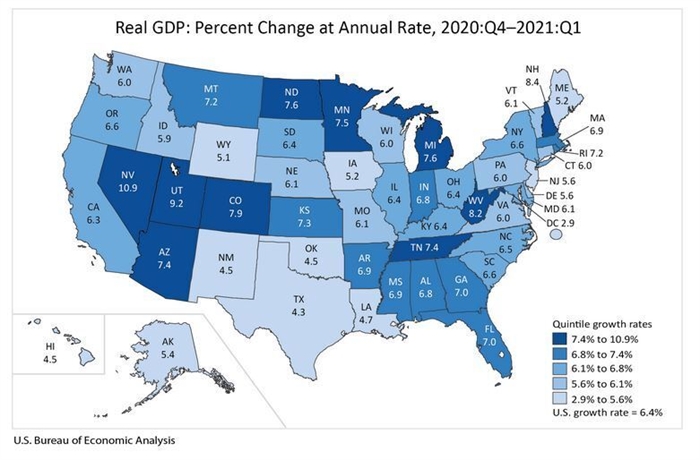By PETER HANCOCK
Capitol News Illinois
SPRINGFIELD – The Illinois economy showed strong signs of recovery during the first quarter of 2021 as businesses continued to reopen from the pandemic and direct government payments flowed to businesses and individual consumers.
Data released last week from the U.S. Bureau of Economic Analysis showed the state’s economy grew at an annual rate of 6.4 percent during the quarter as its gross domestic product – the market value of all goods and services produced by labor and property – approached its pre-pandemic level.
That growth rate was on par with the rest of the nation and slightly ahead of the pace set by most of Illinois’ surrounding states. But the state’s total GDP, at just under $770 billion annually, remained below where it was two years earlier, before the pandemic.
BEA noted that government assistance payments, including direct economic impact payments, expanded unemployment benefits and Paycheck Protection Program loans all flowed to households and businesses during the quarter through the Coronavirus Response and Relief Supplemental Appropriations Act, passed in December, and the American Rescue Plan Act, which passed in March.
But the agency also noted that the full impact of the pandemic could not be quantified in the state GDP numbers because the impacts were generally embedded within the data and could not be separately identified.
“I think that is substantially stimulus, which means borrowing money from China and throwing it into the Illinois economy,” Illinois Chamber of Commerce President Todd Maisch said during an interview. “But there’s no substitute for basic demand in the economy. So as much as (President Joe) Biden wants to spend more and more trillions of dollars, there’s no substitute for basic demand in the economy. And we’re still lacking that, there’s no doubt about it.”
The most improved sectors of the Illinois economy were also among the hardest-hit by the pandemic – arts, entertainment and recreation, which grew at a 38.6 percent annual rate, followed by accommodation and food services, which grew at an 18.4 percent pace.
Durable goods manufacturing also showed strong improvement with a 13 percent growth rate, as did the information sector, which includes the media, which grew at a 14 percent rate.
But with the state’s unemployment rate still relatively high at 7.1 percent, and the overall labor participation rate at only 62 percent, Maisch said the state’s economy is still not fully recovered, and he suggested that some government policies such as enhanced unemployment benefits that are aimed at mitigating the impact of the pandemic might be making things worse.
“That extra payment that you get from unemployment, it really does impact people’s behavior and their willingness to get back in the workforce,” he said.
Maisch also pointed to lingering concerns among many about the safety of returning to the workplace as well as structural issues in the economy such as the inability of many people in the workforce to find affordable child care.
Speaking at an unrelated event in Decatur, however, Gov. JB Pritzker disputed the idea that enhanced unemployment benefits are incentivizing people not to go back to work.
“I think it is a Republican right-wing talking point that says that people are just choosing to be lazy, to stay home, to get the extra few hundred dollars while they can,” Pritzker said.
Pritzker was speaking in Decatur to announce new policies aimed at making child care more affordable for working families so more of them will be able to return to work. That includes reducing the out-of-pocket cost of child care for those who qualify for state subsidies as well as increasing the reimbursement rate the state pays child care providers.
“We’re ensuring quality child care is accessible for more people, allowing more people to return to work without worrying about where their kids will go during the day and helping Illinois’ child care network rebuild after the last 16 months of our COVID-19 crisis,” Pritzker said.








